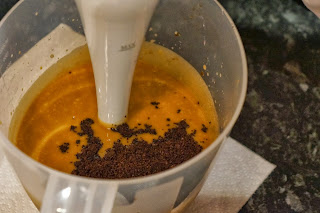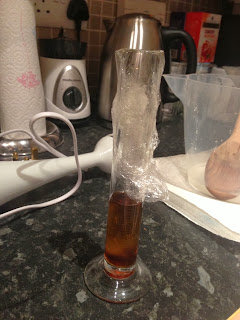I'm being brave and attempting an orange scented soap, I'm going to add milk powder to add extra creaminess hence the name 'orange smoothie'.
I know that it is hard to get citrus scents to stay in soap and have no idea how successful this will be but I've done some research and adding certain complimentary essential oils is supposed to help the scent hold. That's why I have included patchouli, bergamot and lemongrass to the mix. Also adding fresh zest is another method of trying to help the scent to hold.
UPDATE!!!
This soap turned out really well, it was nice and hard so it works really well as a shower soap as it doesn't dissolve in your hands. It has just the right combination of cleansing and moisturising properties for washing your body. The smell is wonderful and has not faded much after curing, the smell really fills the shower cubicle in a morning and it is a great scent to wake up to.
Be sure to read the heath and safety section before attempting to make soap with sodium hydroxide. It is extremely caustic and can cause serious injury if handled incorrectly.
So here goes :
Ingredients
100g Distilled Water (bottled water will do)
70.19g Sodium Hydroxide
250g Olive Oil
100g Lard
150g Coconut Oil
90g Distilled Water mixed with three dessertspoons of milk powder with a few strands of saffron for yellow colouring
Zest of two oranges
20g Sweet orange essential oil
20 drops of bergamot essential oil
30 drops lemongrass essential oil
10 drops patchouli essential oil
Step One
Carefully weigh out the sodium hydroxide and the distilled water in two separate containers. Slowly add the sodium hydroxide bit by bit until it is completely dissolved, stirring with a wooden or plastic spoon. Set aside to cool as it will get quite warm. You can barely see it in the bottom of the jug there is such a small amount.
Melt the oils together over a low heat and also set aside to cool. I also added the orange zest at this point as I wanted the mixture to be as smooth as possible, you can add it when you reach trace if you prefer larger chunks of zest in the soap bars.
Heat up the remaining 90g distilled water and add the strands of saffron, mix until the liquid is a nice shade of yellow then strain out the saffron through a sieve. Add the milk powder to the yellow water and stir until mixed.
At this point I also measure out my essential oils into a glass container, large volumes can take a long time to get out of the bottles drop by drop so I make sure I have everything ready in one place to pour straight into the soap, this will avoid it setting too quickly before getting it into the mold. I then cover the glass container with cling film to keep the strong smell at bay.
Wait until both the sodium hydroxide and oils have cooled to around 35C. You may have to use a bit of cold water in the sink to get one or the other to cool at a faster rate so they both reach the same temperature at the same time.
Combine the oils, sodium hydroxide mix and the milk powder mix.
Start to blend with a hand blender and the oil and water will emulsify and go a creamy colour.
The mixture will quickly heat up due to the sugars in the milk, keep blending and eventually the mixture will start to thicken. I blended for just over 10 minutes before the mixture reached trace. When you pull the blender out the mixture should be thick enough that the drips are visible on the surface of the mixture for a few seconds before disappearing, this is trace. (I couldn't get a good picture of this unfortunately) You must reach this point before putting your mixture into a mold. If you do it too soon then the sodium hydroxide and oils are not sufficiently mixed and your soap will not set properly. At this point I added my essential oils and blended for a few more seconds to make sure the oils were mixed in thoroughly.
Line your soap mold with cling film to make removal much easier. Then pour your soap into the mold, I used a cheap plastic box with a lid from the pound shop. Cover the soap mix with another piece of cling film to prevent soda ash from appearing on the surface. I then put the box lid on to act as a safety measure and prevent spillages.
Your soap mixture should be an opaque creamy yellow colour at this point. Normally you would insulate your soap to make sure the chemical reaction completes fully, but the sugars in the milk react and produce huge amounts of heat so insulation isn't necessary. The soap will change to a dark orange colour and go translucent, this is called gel phase and shows that the reaction is occurring properly.

Leave the soap in the mold for at least 15 hours to ensure the reaction is complete. The soap can then be removed from the mold and cut into bar sized slices. It should be pretty soft but firm enough to handle. If it is still too soft remove any surface coverings and leave to air dry for a bit and hopefully it will harden enough to remove and cut. The soap then needs to be left to air dry or cure for six weeks, during this time it will dry out and become a nice firm bar of soap. I leave mine in my spare bedroom as it is away from my pets and the environment is cool and dry, perfect conditions for curing soap.
I will update this post after the soap has cured and let you know if I was successful in keeping the orange scent from disappearing.

















